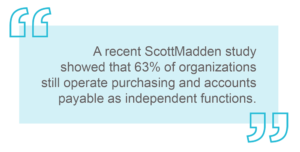
For most companies, the procure-to-pay (P2P) process has evolved to where upstream processes—the world of sourcing and purchasing—and downstream processes—the world of accounts payable—are managed by different organizations and are likely disconnected at key integration points. These disconnects drive rework, inefficiency, frustration, and overall higher costs to serve.
Inherently, business drivers are different for these two groups: “upstreamers” aim to create processes that reduce purchasing costs and deliver goods and services in a timely manner, while “downstreamers” strive to automate high-transactional volumes, quickly solve problems, and ensure financial controls by eliminating payment errors.
 Integrating these processes in an end-to-end (E2E) fashion can deliver the best of both worlds and provide further synergies in automation and error reduction. This is truly a case where 1+1 can equal 3. However, different reporting lines, strategic objectives, and operational mindsets create quite a few challenges in organizing and operating these processes in an “E2E” fashion.
Integrating these processes in an end-to-end (E2E) fashion can deliver the best of both worlds and provide further synergies in automation and error reduction. This is truly a case where 1+1 can equal 3. However, different reporting lines, strategic objectives, and operational mindsets create quite a few challenges in organizing and operating these processes in an “E2E” fashion.
So how do we help these two streams speak the same language? How do we fix the disconnect and “operationalize” the P2P process to better serve the end customer?
The first area of focus is creating alignment within a company for a defined P2P strategy.
We encourage our clients to jointly create a P2P mission statement and define the key guiding principles that can be revisited from time to time to ensure decisions are on track. Additionally, quantifiable metrics and targets tied to employee compensation keep organizations focused on the right objectives.
The second area is developing an effective governance model to evaluate transformation effectiveness and address issues and obstacles as they arise. But, what would that look like?
At a minimum, an executive governance tier is needed to help prioritize improvement opportunities, manage service level agreements, oversee implementation progress, and deal with escalated disputes.
We believe most companies also need a second tier to address more routine tactical decisions. This could be an advisory panel, primarily made up of leaders from the core functional areas, or internal customers within the P2P process who monitor process performance, approve process changes, weigh in on technology investment opportunities, and arbitrate more routine departmental disputes.
As a more aggressive (and often more effective) approach, purchasing and accounts payable activities would report to one P2P manager in the organization. This person would directly oversee the process, identify issues, and fix upstream and downstream problems without having to go through layers of approval or asking permission for simple fixes.
The third area is a defined service delivery model that identifies your customers, your internal menu of P2P services, and leading practice delivery channels to make the overall experience better for your customers. These are typically managers, buyers, vendors, and even government agencies.
Delivery models are typically divided into “tiers” to enable us to think more clearly about the characteristics of the work that are involved vs. the work itself.
.png)
Defining work tiers helps us more clearly align the right skills and compensation levels to the appropriate types of work. This also gives us a clear view of where technology can play a role, such as Tier 0 portals, Tier 1 purchase order matching automation, and Tier 2 issue tracking and management tools.
Getting P2P integration “right” offers tremendous long-term value; however, without a clear strategy, an effective governance model, and a service delivery model that balance efficiency with the ability to differentiate and address strategic purchases, the “upstreamers” and “downstreamers” will struggle to become more integrated.
More Information
Jerred Crosby (jcrosby@scottmadden.com) and Andy Flores (aeflores@scottmadden.com), partners at ScottMadden, lead the firm’s Supply Chain and Finance practices. They meet regularly to think of ways to better coordinate these areas for their clients and often work side-by-side on engagements. Feel free to contact either of them to help you create a P2P (or other E2E) process that will deliver more value to your end customer.
Sussex Economic Advisors is now part of ScottMadden. We invite you to learn more about our expanded firm. Please use the Contact Us form to request additional information.